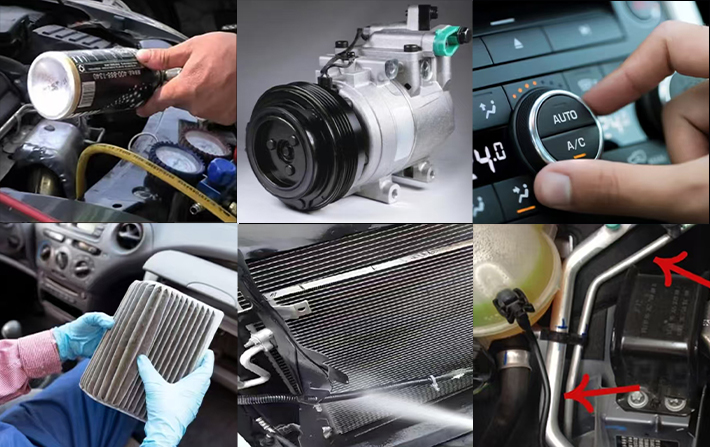Possible Reasons Why Your Car AC Isn't Cooling.
2025-04-21
When summer heat strikes, a malfunctioning car air conditioning system can turn your driving experience into misery. Understanding potential causes of AC failure not only helps diagnose the issue but also enables clearer communication with repair technicians. Below is a detailed analysis of common reasons for car AC cooling failures:

Refrigerant Issues
1. Refrigerant Leakage.
The most common cause of AC failure. Refrigerants (typically R134a or newer eco-friendly variants) circulate in a sealed system. Leaks at joints, condensers, compressor seals, or evaporators will gradually reduce cooling efficiency until it stops entirely.
2. Insufficient or Overcharged Refrigerant.
Natural depletion over time can cause low refrigerant levels, even without visible leaks. Conversely, overcharging raises high-side pressure, impairing cooling performance.
Compressor Failures
1. Clutch Malfunction.
If you hear a "click" when turning on the AC but the compressor doesn’t engage, the clutch solenoid coil or power supply may be faulty. No sound at all suggests circuit issues.
2. Mechanical Damage.
Worn pistons, bearings, or valves prevent proper pressure buildup. Metallic grinding or knocking noises often accompany internal failures.
Electrical System Problems
1. Blown Fuse/Relay.
Check the fuse box first—failed fuses or relays can disable the entire AC system.
2. Pressure Switch Failure.
Faulty high/low-pressure switches may mistakenly cut power to the compressor due to incorrect pressure readings.
3. Sensor or Thermostat Issues.
Automatic climate control systems rely on sensors; a malfunctioning temperature sensor or thermostat can disrupt cooling.
Condenser & Cooling Issues
1. Clogged/Damaged Condenser.
Debris, road debris, or corrosion can block the condenser, reducing heat dissipation and triggering high-pressure shutdowns.
2. Cooling Fan Failure.
A faulty radiator fan reduces airflow at idle or low speeds, drastically lowering cooling efficiency.
Expansion Valve/Orifice Tube Issues
A blocked or malfunctioning expansion valve (or fixed orifice tube) disrupts refrigerant flow:
Low flow causes evaporator frost.
Excessive flow creates abnormal high-side pressure.
Both scenarios impair cooling.
Clogged Cabin Air Filter
A dirty filter restricts airflow, making the AC feel weak. Replace it every 1–2 years or 20,000 km—an often-overlooked fix.
Serpentine Belt Problems
A loose, cracked, or snapped belt prevents compressor operation. Squealing noises often indicate belt slippage.
Troubleshooting Steps
1. Basic Checks
Confirm AC is activated.
Check airflow (identify filter issues).
Observe if the compressor clutch engages.
2. Professional Diagnosis
Pressure/leak tests.
Electrical system inspection.
Performance evaluation.
3. Maintenance Tips
Annual pre-summer AC checks.
Regular filter replacements.
Run the AC monthly (10+ minutes) to prevent seal drying.
Summary
Car AC failures range from simple fixes (e.g., dirty filters) to complex mechanical issues (e.g., compressor failure). Prompt professional diagnosis prevents minor issues from escalating.Note: DIY refrigerant refills may mask leaks—always consult a technician. Proper maintenance ensures cool, comfortable drives even in scorching heat.